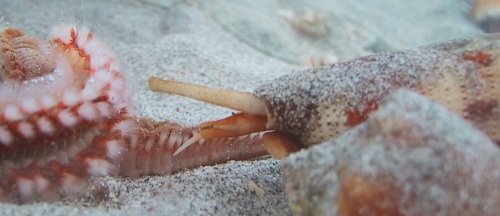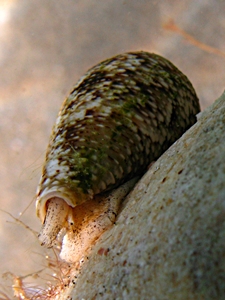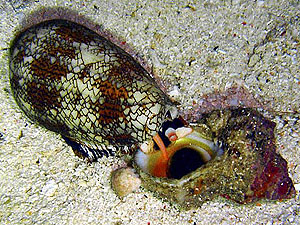
A cone shell (Conus cedonulli, right) attacks a sea worm (Hermodice carunculata, left) to eat it.
Source: David Touitou: "Shelling Dreams".
 A cone shell (Conus cedonulli, right) attacks a sea worm (Hermodice carunculata, left) to eat it. Source: David Touitou: "Shelling Dreams". |
Cone shells are among the shells most liked by collectors. Divers though are well advised to handle the beautiful shells with care. Because, as it is so often the case in nature: Death lurks beyond the beauty. Cone shells are the only members of the gastropod class that may be seriously harmful to man. The venomous sting of some cone shell species may be deadly even for an adult.
The main distribution area of cone shells is the Indopacific, that means the Tropical waters of Indian and Pacific Ocean. An especially large number of species occurs in the area around Australia, thus presenting one more animal group on the long list of venomous animals in that continent. The number of documented cone shell attacks mounts to about 30 cases, all of which are about divers or beach walker that wanted to pick up one of the beautiful shells, not caring about a potential inhabitant.
 Mediterranean cone (Conus mediterraneus). Picture: Hector Giourgis, Eastern Mediterra- nean Inhabitants. |
The only European species is the Mediterranean cone (Conus mediterraneus), compared to that a fairly innocuous small snail, 2 - 3 cm shell length in size, living in the marine sea weed vegetation and feeding on polychaete worms.
Cone shell attacks on man are exclusively defensive.
Cone shells may be carnivorous, but their prey are exclusively smaller sea animals such as other molluscs and worms. About 70 of the larger species (e.g. Conus geographus, Conus textile and Conus magus) also feed on fish. Those are most dangerous to man, as they have the most potent venoms.
 Textile cone (Conus textile, left) eating a turban shell (Turbo sp.). Source: conchology.be (Guido T. Poppe). |
A cone shell's venom apparatus is built by the same basic construction as a Roman snail's rasp tongue, the radula.
The number of teeth in a cone shell's radula, though, is largely reduced: Only one tooth at a time is ready for application. Each one is transformed into a long slim blade rolled together to form a hollow harpoon with a barbed hook. While the pointed end serves to be stung into the prey's body, the harpoon's other end is connected to a venom gland evolved from the a salivary gland. That way, when the harpoon tooth is stung into the prey's body, venom is injected into its organism.
A cone shell's venom, the so called conotoxin, is built from several different oligopeptides (protein molecules consisting of few amino acid components. Together these oligopeptides develop their venomous
effect. Different peptide parts of the venom then affect different parts of the nervous system. Biochemistry discerns five conotoxin families, depending on how they affect certain ion channels of the nervous system. Some omega-conotoxins, for example, can also be applied as painkillers, especially with chronic diseases and cancer patients. Conotoxins seem to have less side effects than morphine derivates. Obviously also there is less risk of addiction. Newer research results, though, point in the direction that conotoxins sometimes do cause severe side effects.|
National Geographic Lovie: Poison in a Cone. Source: YouTube. |
![]() Systematics of Gastropoda: Clade Caenogastropoda: Conidae.
Systematics of Gastropoda: Clade Caenogastropoda: Conidae.
Additional Information
Literature
_____________________________
*) Literature information most friendly provided by Peter Garn.